Apr 24, 2024
“Economic Development is Population Health”: A New Vision for Rural Hospital Leadership
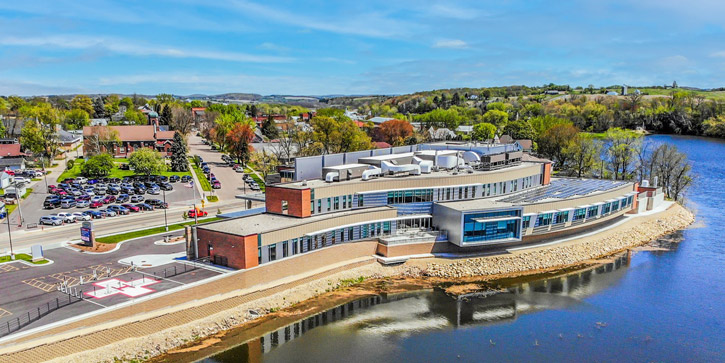
In 2018, the leadership team at Gundersen St. Joseph's, a Critical Access Hospital in Hillsboro, Wisconsin, was faced with a seemingly obvious choice. The time had come to replace their 1950s facility, located in Hillsboro's struggling downtown. Recently, Gundersen had purchased a greenfield site on the outskirts of town, which was ripe for development. Alternately, they could build in the lot immediately adjacent to their current facility. This would be more complicated, disruptive, and expensive — plus, they wouldn't have access to the front door of the new building for six months, until the old hospital could be demolished and turned into a parking lot.
“When we talked to the staff and the community, we heard so many times: ‘Don't take this out of the city limits,’” said Kristie McCoic, Administrator at Gundersen St. Joseph's. The hospital is the largest employer in town, with around 200 staff members — many of whom stop at downtown businesses on their lunch breaks or after work. “If we took the building out of town, we were going to lose that,” she said.
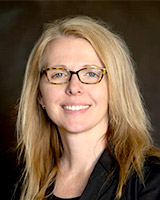
For McCoic, who was born in the old hospital and raised in Hillsboro, the stakes were personal. After moving away for college, she and her husband returned to the community before the birth of their first child. “We wanted to raise our family in a small community where the kids drove their tractors to school for FFA week,” she said. Now, from an administrative perspective, she understood the importance of Hillsboro's economic vibrancy for recruiting the next generation to “come back and live here just like we did.”
In June 2020, amidst the economic uncertainty of a global pandemic, a $33.1 million-dollar hospital opened its doors in downtown Hillsboro. According to McCoic, the new building could have allowed for the relocation of a Gundersen-affiliated vision center from a separate building down the street — but “that would've left an empty building downtown.” Instead, they renovated the building and kept the business where it was.
McCoic says these investments have had a positive effect on the local business climate, but her organization ultimately hopes the impacts will be felt far beyond main street. “These decisions were led by our belief that economic development is population health,” she said. Gundersen St. Joseph's is joined in this belief by a growing number of hospitals who have begun to view their infrastructure, purchasing, and investment strategies as crucial extensions of their efforts to improve community health — and, in the long term, bolster their bottom line.

“We know that access to clinical care only contributes to 20% of individual health outcomes, whereas factors such as where you live, if you have transportation, if you have access to a good education or a well-paying job, contribute to about 50% of individual health outcomes,” said Marie Barry, Director of Community Economic Development at the Rural Wisconsin Health Cooperative (RWHC). In this role, she helps member hospitals — including Gundersen St. Joseph's — implement strategies to positively impact their local economies.
Barry is aware that, to some, this work may seem like another unneeded burden placed on the shoulders of our nation's straining rural healthcare system. But recent research suggests that community economic health and hospital financial viability are closely linked. “If a community is struggling, oftentimes their hospital is struggling — so impacting those community conditions not only improves patient health, it improves the financial viability of the hospital and their ability to continue to provide care locally,” she said.
If a community is struggling, oftentimes their hospital is struggling.
According to Barry, there has been “consistent growth” in recent years in the number of RWHC members engaging in economic development activities. “The majority of our members are interested but trying to figure out what it looks like in their community, how they build the capacity to engage, and what the partnerships could be,” she said. “But then we have some that are so involved in local economic development that you couldn't pull them out if you tried, because you'd miss ten places where they were engaged.”
Gundersen St. Joseph's falls squarely within this latter camp. In addition to their infrastructure investments in downtown Hillsboro, the organization supports health career programming in local schools and offers grant-writing assistance to local nonprofits. They also work to purchase food, services, and supplies from local businesses whenever possible — and encourage others to do the same. “When we have vendors come to town, they know that we're going to ask them where they stayed, and it better be the hotel in town,” said McCoic. “We make it clear that if you want to do business with us, you support our local community.”
New Priorities Lead to New Partnerships
While some may associate the term economic development with business attraction efforts and corporate tax incentives — a strategy known in the field as “chasing smokestacks” — according to Barry, “that's just not what the field is anymore.” Today, due to a combination of economic, technological, and generational changes, working-age people often “pick where they want to live, then find a job,” rather than the other way around, said Barry. As a result, many in the economic development sector have become more focused on placemaking and quality-of-life initiatives — such as recreational opportunities, well-funded public services, and thriving arts and entrepreneurial communities.
We are now realizing that access to individual clinical care is not enough to create thriving communities.
Meanwhile, the healthcare industry has shifted in a similar, more community-minded direction — led by a deepening awareness of the social determinants of health and the emergence of value-based reimbursement models, which incentivize more holistic approaches to care. “We are now realizing that access to individual clinical care is not enough to create thriving communities,” said Ruth Thomas-Squance, Co-Executive Director of Build Healthy Places Network (BHPN). “We have to think about everything in a person's environment, and economic stability — and everything that goes with that — is a major factor.”
BHPN, a program of the Public Health Institute, is a national nonprofit that works to foster collaboration between the healthcare, public health, community development, and financial sectors. The organization was founded in 2014 to connect organizations with similar values and goals that “are working in parallel and could achieve a lot more if they worked together,” said Thomas-Squance. In the decade since, BHPN has emerged as a key resource hub and convener for organizations, including healthcare, looking to form new, multisector partnerships to expand their upstream community impacts.

According to Thomas-Squance, throughout BHPN's earlier years, the organization often heard some version of the following comment at events and webinars: This sounds great, but how does it work in rural? In response, the organization developed A Playbook for New Rural Healthcare Partnership Models of Investment, featuring case studies and best practices gleaned from interviews with rural healthcare leaders and their multisector partners across the country. “One of the things that came out of that process was realizing that any notion of, ‘Oh, there's nothing happening in rural,’ was completely wrong,” said Thomas-Squance. “We just didn't have the case studies. It may look different and happen on a different scale, but innovation is definitely happening in rural spaces.”
One notable project featured in the playbook was led by Dartmouth Health, an academic medical center based in Lebanon, New Hampshire. Working in collaboration with a local community action agency, Dartmouth Health provided seed funding that led to the creation of a public bus route connecting Lebanon to a nearby community. “When industry moved out, they lost a lot of their economic base,” said Greg Norman, Senior Director of Community Health at Dartmouth Health. “We looked at the map and realized: We have great jobs and they have comparatively affordable housing and a workforce that is highly skilled, so supporting public transportation between these communities could benefit both.” The thrice-daily bus service has now been operational for over three years.
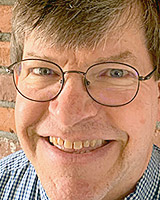
Another recent Dartmouth Health-led initiative is less tangible than a bus, but potentially even more impactful. In recent years, the organization has redirected a portion of its reserves from traditional financial vehicles (like Wall Street stocks and bonds) to a local fund designed to spur affordable housing development in the region. And they've convinced a handful of powerful local institutions — including three banks, a college, and a large manufacturer — to join them. Together, the group has invested $9.5 million at 1.5% return, creating a pool of low-interest capital to entice developers.
The Upper Valley Loan Fund, managed by Evernorth, a regional nonprofit housing organization, is off to a strong start: Four projects, totaling 192 apartments, are already in development. Norman expects the fund will facilitate the construction of 250 units in total, with a majority reserved for households making 50%-80% of the Area Median Income. The co-investors are enthusiastic about the fund's impacts to date and are exploring ways to build on this success.
Dartmouth is also leveraging its financial resources to help preserve housing that already exists. According to Norman, mobile homes offer one of the most prevalent forms of affordable housing in rural New Hampshire. However, mobile homeowners often pay rent for the use of land, and parks are vulnerable to buy-outs by developers of single-family homes. In response, Dartmouth has invested a total of $5 million in the New Hampshire Community Loan Fund, a community development financial institution (CDFI) that specializes in helping mobile homeowners form arrangements to cooperatively purchase the land where their homes are located.
“We lend part of our reserves at 1% interest, and the Community Loan Fund then relends that capital at far less than market rates to these cooperative groups that are purchasing tracts of land,” said Norman. “The residents of these communities include our patients and staff members. So even though we could probably earn a higher rate of return through more traditional investment approaches, the return on investment of maintaining that housing in our communities is of far greater value to us.”
Resource Spotlight
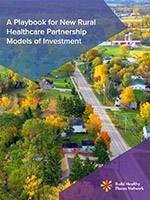
BHPN's 2022 publication, A Playbook for New Rural Healthcare Partnership Models of Investment, includes additional examples of innovative multi-sector collaboration to impact local economic conditions and other social determinants of health. The playbook highlights the importance of “applying an equity lens” throughout the project development process, noting: “The centering of rural communities, particularly groups within rural communities whose voice and power are commonly excluded, is important in rural development and investment partnerships.”
Opportunities for Low-Cost Engagement
Dartmouth Health's multi-million-dollar community investments, while admirable, may not be a realistic option for some cash-strapped rural hospitals. But even relatively small investments can have big impacts in rural communities — and some of the most important engagement strategies may require no financial commitment at all. “In rural areas, healthcare institutions are like a gravitational force center,” said Thomas-Squance. “They have an outsized influence on the communities they serve, so they can be excellent partners on initiatives led by other community-based organizations.”
For example, Dartmouth Health strives to be “the first dollar in the door” for promising initiatives led by community partners. “Health systems have the ability to use their high visibility to signal communities about what's important,” said Norman. “Even a modest gift from us as a health system allows that organization to look to other partners and say, ‘Hey, Dartmouth Health has stepped up’ — and there is value in that that is much greater than the dollars we provide.”
In general, Norman cautioned hospitals — however small or strained — against becoming fixated on a perceived lack of resources. “We frequently get stuck on dollars, but in rural communities, hospitals also have incredible expertise,” said Norman. Beyond medical professionals, hospitals employ many other highly educated individuals with years of experience in the realms of finance, communications, and project management. “Being able to lend out that expertise is one way to contribute to complex community change,” he said.
At Gundersen St. Joseph's, McCoic works to empower her staff to contribute their time and talents outside of the hospital's walls. She shared the example of their marketing manager, Dan Howard, who has been “very involved with the newly established Hillsboro Chamber of Commerce, helping it get off the ground.” Howard has also written grants for a wide range of local partners, resulting in funding for equipment for the local ambulance service and new windows and freezers for the local food pantry — to name just two from a growing list of outcomes. “That's part of his job here,” said McCoic. “I don't expect him to go home and do that after hours.”
Rural is about relationships.
The way she sees it, the greatest asset many rural hospitals have is the tight-knit, interconnected social fabric of their communities. Anything her employees can do to build relationships and support the success of other community institutions will ultimately benefit the hospital as well. “Rural is about relationships,” said McCoic. “We live in a small town because we want to know our neighbors, we want to be involved in things. I want to know the school superintendent and the restaurant owners and be able to call them up and say, ‘Hey, do you want to do this? What do you think about this idea?’”
While seemingly insignificant, phone calls like these are an essential starting point for the most frequently recommended low-cost engagement strategy of all. In a 2021 publication, The Hospital As Convener in Rural Communities, the American Hospital Association advised rural hospitals to leverage their social capital to initiate and hold space for conversations about community needs “without shouldering the burden of providing those services independently.”
It's a strategy that Barry often recommends to RWHC member hospitals — and which she has seen yield unexpected results. One hospital convened a meeting of local employers to discuss workforce shortages. “They realized that one of the sources of hope for their community in terms of workforce was immigrants, but currently their community was not perceived as welcoming,” said Barry. Soon, an inclusivity initiative took shape. Multiple other RWHC members are currently working to convene local leaders to explore solutions to childcare shortages.
While these conversations can be an essential step towards addressing immediate challenges, Barry is also enthusiastic about the long-term impacts. “When you see a hospital that's able to pull together community leaders and create a working group to take on childcare or immigrant inclusion or whatever it might be, they're not only solving the challenge of the moment — they're creating the trust and partnerships that they need to solve challenges down the road,” she said. “It gives me hope for the future.”
Resource Spotlight
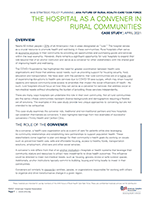
The American Hospital Association's 2021 case study, The Hospital as a Convener in Rural Communities, offers an in-depth consideration of the convener strategy and examples of successful implementation. Regarding evaluation, the report notes: “Convening efforts may be challenging to capture through traditional quantitative measures. As such, health care organizations can build and define qualitative indicators for success, such as the strength of partnerships and patient satisfaction, to measure their efforts' effectiveness.”
Redefining Rural Hospital Leadership
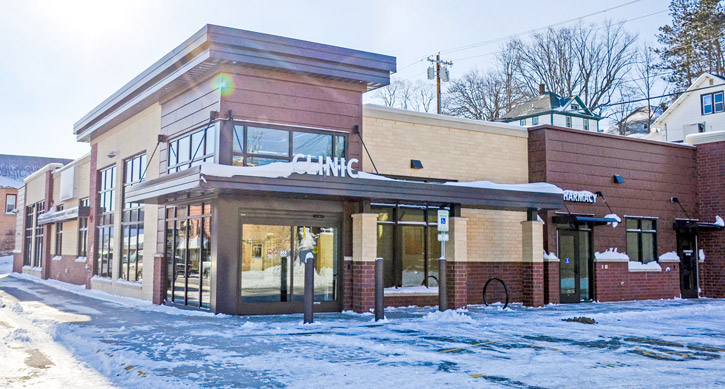
In 2023, Gundersen St. Joseph's broke ground on another major infrastructure project — this time in the neighboring town of Elroy, where they operate a clinic. When discussions began regarding the replacement of the original clinic building — located “at the very end of town” — a representative of the city council approached the leadership team to see if they would consider relocating. They had a downtown lot in mind but admitted it would need some work.

After Gundersen expressed openness to the idea, the City of Elroy funded the installation of an extensive cement wall on the site to mitigate an incline and closed a portion of a street to accommodate the project. Then, an informal group called Forward Elroy purchased a neighboring building, demolished it, and sold Gundersen the lot. McCoic described the experience as “a model for how economic development should be done in a small town.” As a bonus, after Gundersen had already committed to relocating to the site, they received a $4.2 million-dollar Healthcare Infrastructure Grant from the State of Wisconsin Department of Administration to assist with construction costs; the City of Elroy received $2 million to help cover their investments in the project.
When the clinic opened in January, a press release described it as “a new cornerstone of the city's downtown and a starting point for its revitalization.” A few months later, there are already signs of new life. Currently, a coffee shop is preparing to open across the street. The downtown restaurant is enjoying a steadier stream of customers. And the clinic is offering a popular new service: additional downtown parking.
“Pretty much any time I go by there, evenings or weekends, the parking lot is being used,” said McCoic. “Elroy still has a movie theatre, and on movie theater nights, people are in that parking lot. That makes us happy, because it's made it easier for people to go out in downtown Elroy — and that's the point.”
According to Barry, one of RWHC's loftier, long-term goals is to “redefine what it means to be a rural hospital leader” so that involvement in local economic development is widely understood to be part of the job. At least one of their members seems to have enthusiastically embraced this new job description. At the close of a recent interview, McCoic offered an open invitation: “Do you like canoeing? The Kickapoo River is amazing. So if you're looking for a great weekend trip this summer, let me know. We'll tell you all the local places to eat.”

